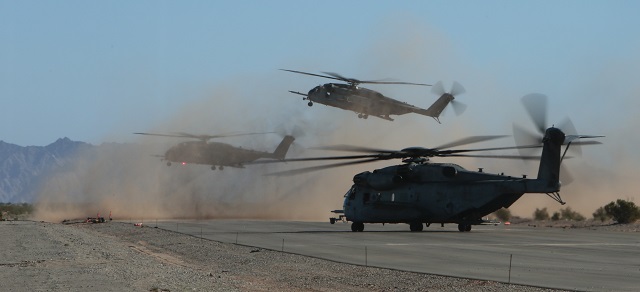The US Marine Corps is pressing forward with a fleet-wide maintenance reset of the Sikorsky CH-53E Super Stallion as it awaits delivery of the CH-53K King Stallion replacement, which has flown for the first time with an external load.
Speaking at a congressional hearing on 20 April, USMC deputy commandant for aviation Jon Davis said the E-model has “probably the worst” readiness rate in the service’s aviation inventory.
An independent assessment concluded that not enough attention has been paid to the heavy-lift type after 13 years of punishing combat operations in the Middle East and many CH-53 pilots haven't been able to log enough flight time because their aircraft are grounded for repairs.
In response, Davis says every CH-53 helicopter will undergo 100 days of heavy maintenance and the lead aircraft of that initiative is now flying. It will take approximately three years to overhaul all 140 USMC Super Stallions at a rate of 48 overhauls per year.

CH-53E Super Stallions train in Yuma, Arizona
US Marine Corps
According to written testimony, the difficulty of maintaining the CH-53E and 28 MH-53E Sea Dragon minesweepers underscores the importance of fielding the King Stallion – a programme that was launch in 2003 and is currently tracking toward service entry in fiscal year 2019.
The CH-53E community has logged 95,000 combat flight hours since the invasion of Iraq in 2003 and has lost fourteen aircraft in that time, including two that collided during a nighttime training exercise at sea in Hawaii. Of those 14 losses, half were combat losses and the other seven were training accidents.
In a significant milestone for the CH-53K programme, one of the two flight test aircraft at Sikorsky's plant in West Palm Beach, Florida has lifted a 5.4t (12,000lb) external load. The next step is to carry that external load at 120kt (222km/h) before switching to 9t (20,000lb) and eventually 12t (27,000lb) loads.

CH-53K King Stallion conducts first external load lift
Sikorsky
The ultimate goal is for the aircraft, designed with three GE Aviation T408-400 engines and seven composite main rotor blades, to carry a 12t payload over 110nm in the most difficult conditions helicopter — in density altitudes up to 6,000ft with temperatures up to 35°C (95°F).
The aircraft has three cargo hooks to carry independent loads or lift one 16t (36,000lb) load.
“Our flight envelope expansion efforts remain on track, and we continue to make good progress toward our initial operational test assessment later this year, and ultimately full aircraft system qualification,” says Sikorsky's vice-president of CH-53K programmes Mike Torok.
The CH-53K first flew on 27 October 2015 and the second aircraft joined the flight test campaign in January. Sikorsky says the King Stallion test fleet has logged 50 flight hours and reached the desired speed of 140kt (259km/h). The remaining two test assets will be ready “this summer”.

Artists impression of the CH-53K external cargo hook system
Sikorsky
Source: FlightGlobal.com
















